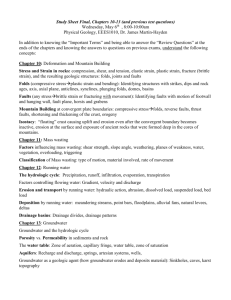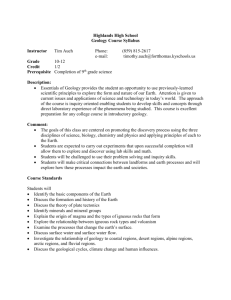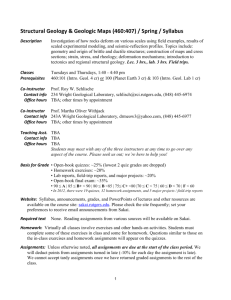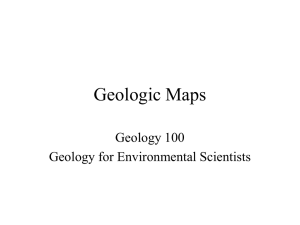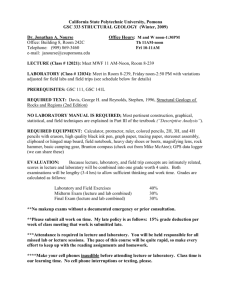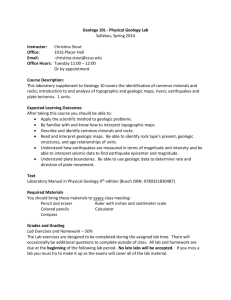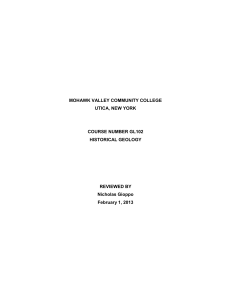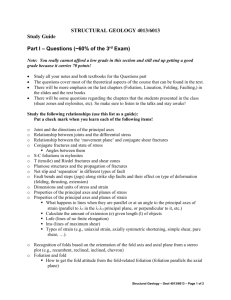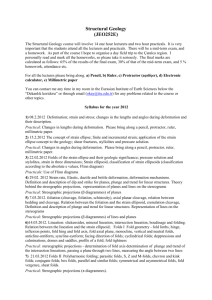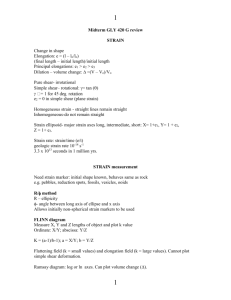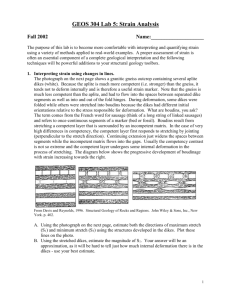Structural Geology Fall 2011
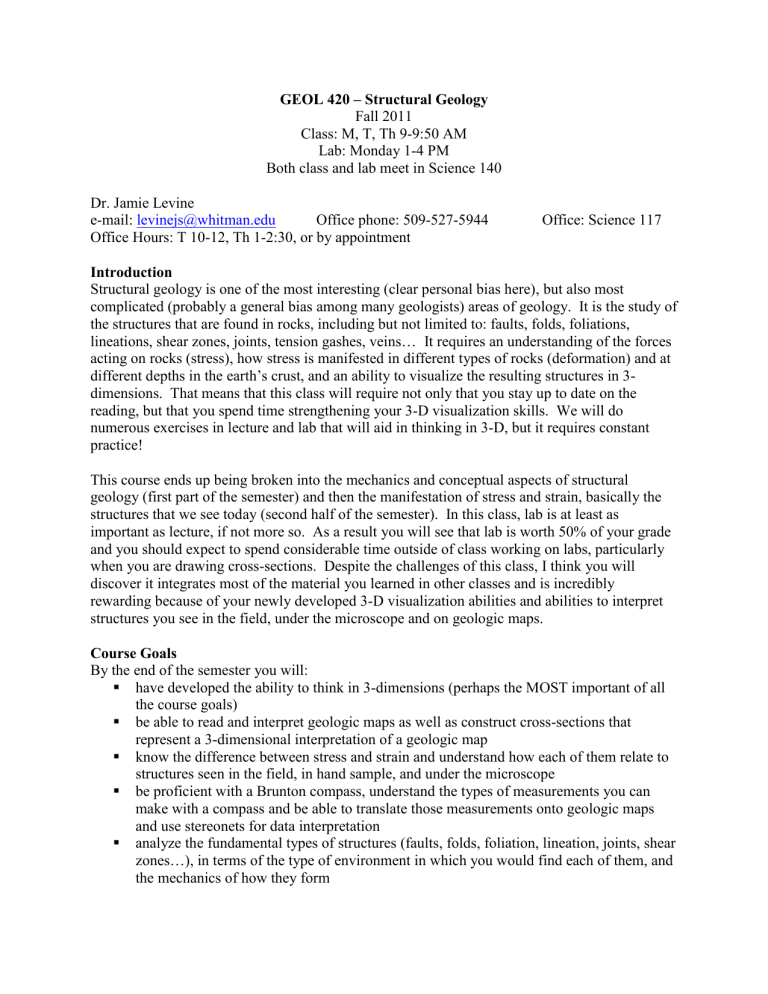
GEOL 420 – Structural Geology
Fall 2011
Class: M, T, Th 9-9:50 AM
Lab: Monday 1-4 PM
Both class and lab meet in Science 140
Dr. Jamie Levine e-mail: levinejs@whitman.edu
Office phone: 509-527-5944
Office Hours: T 10-12, Th 1-2:30, or by appointment
Introduction
Office: Science 117
Structural geology is one of the most interesting (clear personal bias here), but also most complicated (probably a general bias among many geologists) areas of geology. It is the study of the structures that are found in rocks, including but not limited to: faults, folds, foliations, lineations, shear zones, joints, tension gashes, veins… It requires an understanding of the forces acting on rocks (stress), how stress is manifested in different types of rocks (deformation) and at different depths in the earth’s crust, and an ability to visualize the resulting structures in 3dimensions. That means that this class will require not only that you stay up to date on the reading, but that you spend time strengthening your 3-D visualization skills. We will do numerous exercises in lecture and lab that will aid in thinking in 3-D, but it requires constant practice!
This course ends up being broken into the mechanics and conceptual aspects of structural geology (first part of the semester) and then the manifestation of stress and strain, basically the structures that we see today (second half of the semester). In this class, lab is at least as important as lecture, if not more so. As a result you will see that lab is worth 50% of your grade and you should expect to spend considerable time outside of class working on labs, particularly when you are drawing cross-sections. Despite the challenges of this class, I think you will discover it integrates most of the material you learned in other classes and is incredibly rewarding because of your newly developed 3-D visualization abilities and abilities to interpret structures you see in the field, under the microscope and on geologic maps.
Course Goals
By the end of the semester you will:
have developed the ability to think in 3-dimensions (perhaps the MOST important of all the course goals)
be able to read and interpret geologic maps as well as construct cross-sections that represent a 3-dimensional interpretation of a geologic map
know the difference between stress and strain and understand how each of them relate to structures seen in the field, in hand sample, and under the microscope
be proficient with a Brunton compass, understand the types of measurements you can make with a compass and be able to translate those measurements onto geologic maps and use stereonets for data interpretation
analyze the fundamental types of structures (faults, folds, foliation, lineation, joints, shear zones…), in terms of the type of environment in which you would find each of them, and the mechanics of how they form
be able to write a structural history, combining observations from geologic maps, interpretations from cross-sections and relying on cross-cutting relationships and relative age constraints
Classroom Philosophy
This is not a class where you can sit quietly and take notes. I expect you to ask questions and I will ask questions of you throughout class. You should come to class prepared to participate!
Please ask any questions that you have (don’t be shy), and if you are working on an assignment or are reading and come up with questions, feel free to e-mail me or write them down to ask at the beginning of class. We will also work in groups frequently in lab, and you may do some short exercises in class in small groups or pairs. I urge you to work and study in groups, because everybody has different strengths and you will learn material much better if you are explaining it to or discussing it with your peers.
Classroom Courtesy
Please turn your cell phones to silent before you come into class and keep them away throughout class and lab. Plan to stay in lab for the entire three hours – if you leave early, I will be less inclined to help you with any questions you may have. We will be sharing the classroom/lab room with students taking Intro, so please put any materials away at the end of class/lab and clean up after yourselves.
Accommodation and Disability Policy
If you are a student with a disability who will need accommodations in this course, please meet with Julia Dunn, Director of Academic Resources (Mem. 205, x5213, dunnjl@whitman.edu
) for assistance in developing a plan to address your academic needs. All information about disabilities is considered private; if I receive notification from Ms. Dunn that you are eligible to receive an accommodation, I will provide it in as discrete a manner as possible.
Academic Honesty
Academic dishonesty is a serious offense and will not be tolerated in this course. Whitman
College has defined academic dishonesty as:
“Falsification, misrepresentation of another’s work as one’s own (such as cheating on examinations, reports or quizzes), plagiarism from the work of others, or the presentation of substantially similar work for different courses (unless authorized to do so), is academic dishonesty and is a serious offense. Knowingly helping other students cheat or plagiarize also will be considered academic dishonesty.” (see the student handbook for guidelines on what constitutes plagiarism and for details on procedures and penalties)
*A first offense will result in a zero (0) on the assignment and notification of the office of the
Dean of Students. Depending on the severity of the infraction, a grade of F may be given for the entire course. A second offense will result in a case being brought to the Council of Student
Affairs and may result in expulsion.
Late Work Policy
Assignments are due on the date they are listed on the syllabus. You will lose 10% of the grade for each day it is late, so seriously consider whether it is worth it to you, to turn things in late.
Labs will be due at the BEGINNING of the following lab period (unless stated otherwise). No make-up exams will be given unless I have received notification from the Dean of Students. If
you are ill and cannot attend class or lab, please send me an e-mail. If you are quite sick, please do not attempt to come to class/lab as the rest of us would like to retain our good health.
Required Materials protractor, ruler, calculator, colored pencils, fine-tipped black pens (drafting pens), mechanical pencils (best to have 0.5 mm), tracing paper, graph paper (recommended), compass
(recommended)
Textbook: Davis, G.H., and Reynolds, S.J., 1996, Structural Geology of Rocks and Regions, 2 nd edition, Wiley and Sons, New York, 776 p.
Throughout the semester we will be reading a few articles from the literature about specific aspects of structural geology. These are designed to aid in your scientific reading abilities, but also to look in depth at topics that are actively being researched and that your book may not cover in much detail. I will typically post these on CLEo, so that you can access them easily.
They are not listed under readings on the syllabus at the moment, but I will notify you when there are additional readings.
Additional Structural Geology Resources
Marshak, S., and Mitra, G., 1988, Basic Methods of Structural Geology, Prentice Hall, New
Jersey, 446 p.
Passchier, C.W., and Truow, R.A.J., 2005, Microtectonics, 2 nd
edition, Springer, New York, 366 p.
Twiss, R.J., and Moores, E.M., 1992, Structural Geology, W.H. Freeman and Company, 532 p. van der Plujim, B.A., and Marshak, S., 2003, Earth Structure: An Introduction to Structural
Geology and Tectonics, 2 nd
edition, W.W. Norton and Company, 672 p.
Grade Breakdown
Lab Exercises 40% Lab Exercises Each cross-section 7.5%
Midterm
Quizzes/Participation/Homework
20%
10%
Each report 5%
The rest: 15%
Final
Lab Final
20%
10%
Field Trip
I have a field trip tentatively scheduled for Monday November 7 th
, but it will require departing outside of lab hours. We will discuss the logistics during the first class time to determine whether it is feasible.
VARK Link http://www.vark-learn.com/english/index.asp
Please send me your results by 10pm Wednesday (August 31 st
) night.
TENTATIVE (Subject to revision) Course Schedule
Day Structure Class Subject Reading
T-Aug 30th Intro
Th-Sep 1st Intro
M-Sep 5th Geologic Maps
T-Sep 6th Geologic Maps
D&R: Chapter 1
D&R: Appendices B-D Lab
(p. 645-669)
Th-Sep 8th no class
M-Sep 12th Geologic Maps/Fold Patterns D&R: Chapter 3 (p.98Lab
T-Sep 13th Stress
Th-Sep 15th Stress
122)
D&R: Chapter 2 Lab M-Sep 19th Stress
T-Sep 20th Stress/Strain
Th-Sep 22nd no class (Regional Field trip)
M-Sep 26th Strain Lab
T-Sept 27th Strain
Th-Sept 29th Strain
M-Oct 3rd Stress and Strain
T-Oct 4th Stress and Strain
Th-Oct 6th Stress and Strain
M-Oct 10th no class (Fall Break)
T-Oct 11th no class (Fall Break)
Th-Oct 13th Midterm
D&R: Chapter 3 (p. 122-
149)
D&R: Chapter 4 Lab
Lab
D&R: Chapter 4 Lab M-Oct 17th Deformation Mechanisms
T-Oct 18th Deformation Mechanisms
Th-Oct 20th Deformation Mechanisms
M-Oct 24th Joints and Shear Fractures
T-Oct 25th Joints and Shear Fractures
Th-Oct 27th Joints and Shear Fractures
M-Oct 31st Faults and Fractures
T-Nov 1st Faults and Fractures
Th-Nov 3rd Faults and Fractures
M-Nov 7th Folds
T-Nov 8th Folds
Th-Nov 10th Folds
M-Nov 14th Fabrics
T-Nov 15th Fabrics
Th-Nov 17th Fabrics
D&R: Chapter 5
D&R: Chapter 6
D&R: Chapter 7
D&R: Chapter 8
Lab
Lab
Lab
Lab
M-Nov 21st no class (Thanksgiving)
T-Nov 22nd no class (Thanksgiving)
Th-Nov 24th no class (Thanksgiving)
M-Nov 28th Shear Zones
T-Nov 29th Shear Zones
Th-Dec 1st Shear Zones
M-Dec 5th Tectonics
T-Dec 6th Tectonics
Th-Dec 8th Review and Evaluations
Th-Dec 15th Final (9-11am)
D&R: Chapter 9
D&R: Chapter 10
Lab
Lab
Lab
Strike and dip/Intro to
Maps/Attitudes of lines and planes
Structure contours and outcrop patterns/Intro to Mapping
Trig/Thickness Problems/Map
Interpretation
Stereonets 1
Stereonets 2 no class (Fall Break)
Stereonets 3 and Report
Cross-section 1
Cross-section 1 continued
Field Trip
Cross-section 2 + Report no class (Thanksgiving)
Hand Samples and Microstructures
(Lab Meets in 112 - Min classroom)
Lab Final

